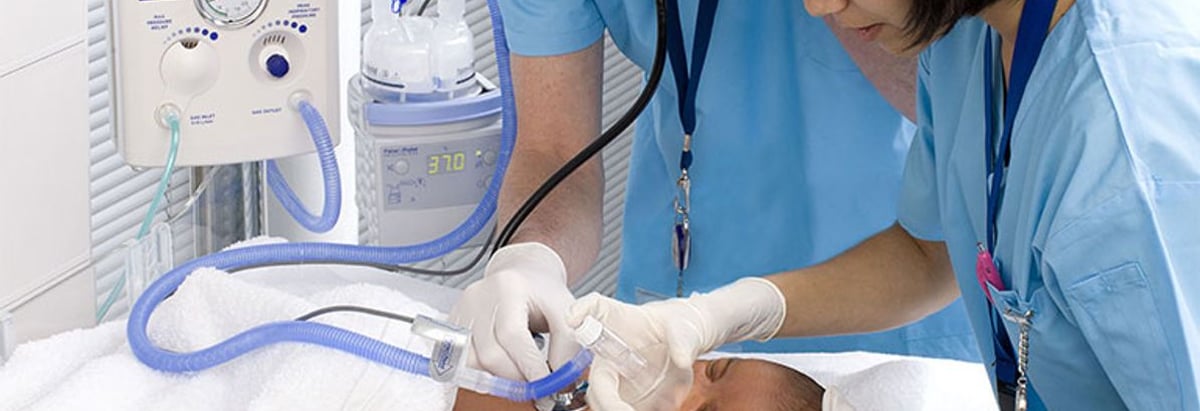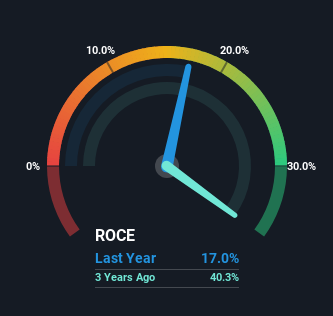- New Zealand
- /
- Medical Equipment
- /
- NZSE:FPH
Be Wary Of Fisher & Paykel Healthcare (NZSE:FPH) And Its Returns On Capital

If we want to find a stock that could multiply over the long term, what are the underlying trends we should look for? Ideally, a business will show two trends; firstly a growing return on capital employed (ROCE) and secondly, an increasing amount of capital employed. Basically this means that a company has profitable initiatives that it can continue to reinvest in, which is a trait of a compounding machine. Having said that, from a first glance at Fisher & Paykel Healthcare (NZSE:FPH) we aren't jumping out of our chairs at how returns are trending, but let's have a deeper look.
Return On Capital Employed (ROCE): What Is It?
For those who don't know, ROCE is a measure of a company's yearly pre-tax profit (its return), relative to the capital employed in the business. The formula for this calculation on Fisher & Paykel Healthcare is:
Return on Capital Employed = Earnings Before Interest and Tax (EBIT) ÷ (Total Assets - Current Liabilities)
0.17 = NZ$358m ÷ (NZ$2.4b - NZ$287m) (Based on the trailing twelve months to September 2023).
Thus, Fisher & Paykel Healthcare has an ROCE of 17%. In absolute terms, that's a satisfactory return, but compared to the Medical Equipment industry average of 9.4% it's much better.
Check out our latest analysis for Fisher & Paykel Healthcare

Above you can see how the current ROCE for Fisher & Paykel Healthcare compares to its prior returns on capital, but there's only so much you can tell from the past. If you'd like to see what analysts are forecasting going forward, you should check out our free analyst report for Fisher & Paykel Healthcare .
The Trend Of ROCE
On the surface, the trend of ROCE at Fisher & Paykel Healthcare doesn't inspire confidence. To be more specific, ROCE has fallen from 36% over the last five years. However, given capital employed and revenue have both increased it appears that the business is currently pursuing growth, at the consequence of short term returns. If these investments prove successful, this can bode very well for long term stock performance.
In Conclusion...
While returns have fallen for Fisher & Paykel Healthcare in recent times, we're encouraged to see that sales are growing and that the business is reinvesting in its operations. And the stock has followed suit returning a meaningful 77% to shareholders over the last five years. So while the underlying trends could already be accounted for by investors, we still think this stock is worth looking into further.
Fisher & Paykel Healthcare could be trading at an attractive price in other respects, so you might find our free intrinsic value estimation for FPH on our platform quite valuable.
While Fisher & Paykel Healthcare isn't earning the highest return, check out this free list of companies that are earning high returns on equity with solid balance sheets.
New: AI Stock Screener & Alerts
Our new AI Stock Screener scans the market every day to uncover opportunities.
• Dividend Powerhouses (3%+ Yield)
• Undervalued Small Caps with Insider Buying
• High growth Tech and AI Companies
Or build your own from over 50 metrics.
Have feedback on this article? Concerned about the content? Get in touch with us directly. Alternatively, email editorial-team (at) simplywallst.com.
This article by Simply Wall St is general in nature. We provide commentary based on historical data and analyst forecasts only using an unbiased methodology and our articles are not intended to be financial advice. It does not constitute a recommendation to buy or sell any stock, and does not take account of your objectives, or your financial situation. We aim to bring you long-term focused analysis driven by fundamental data. Note that our analysis may not factor in the latest price-sensitive company announcements or qualitative material. Simply Wall St has no position in any stocks mentioned.
About NZSE:FPH
Fisher & Paykel Healthcare
Designs, manufactures, markets, and sells medical device products and systems in North America, Europe, the Asia Pacific, and internationally.
Flawless balance sheet with reasonable growth potential.


